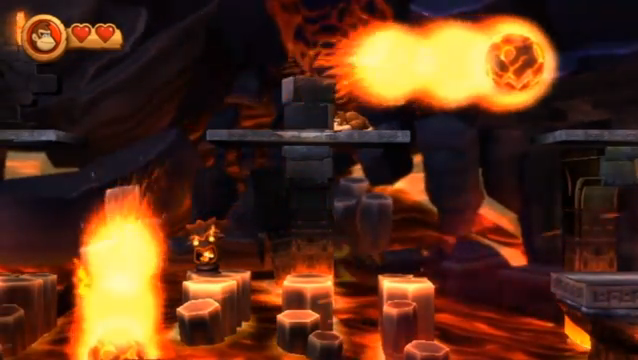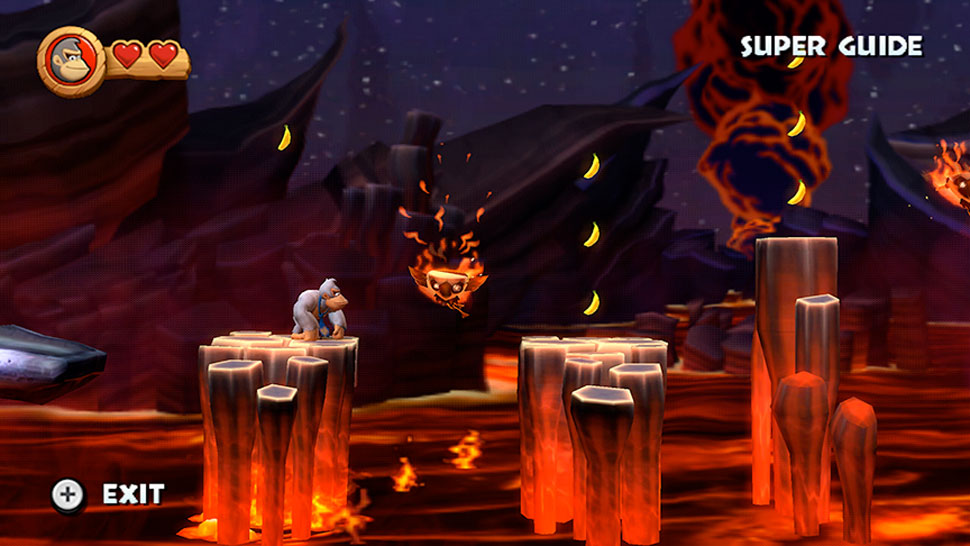Last updated on April 13, 2014
All of these great elements submit to the precision of the controls, which surprised me. Yes, the remote-wiggling gimmick will make some areas a chore. Rolling jumps require running while wiggling and then jumping, which often can throw off your timing. Rambi’s charge also requires it, and while only one stage in particular demands that you use it, it’s a head-scratcher as to why it comes so late in the game. Other than that, though, there’s a unbelievable precision to the controls and the demands of the system. Just try jumping on enemies from different angles, and you’ll see that each one has a very specific hitbox that distinguishes a successful hit from one where you take damage. Donkey and Diddy Kong easily fall off platforms (and yes, bump their head into them if you jump at them from the incorrect angle), and only your control of their forward momentum will achieve success. Now imagine doing all of that while having nearly zero time to think, and you can see the challenge.

If there’s one fatal flaw, I found it far too easy to obtain 99 lives without even trying; any one who plays with a minor degree of competence will find themselves with the same problem. I completed it in the 6-8 hour range, mostly due to playing the game half co-op, and half not. I can assure you, this isn’t the ideal game for co-op (nor did Shigeru Miyamoto see it as a necessary feature either). Most of the latter parts of the game require a twin synchronicity if you want to control both characters separately, and it just becomes less fun as a result. The pace requires a singular focus and drive; playing with a friend will take away two lives when you die and increase the difficulty substantially if there’s a skill disparity. I guess you could use the (dumb) Super Guide feature which plays the level for you, but what’s the fun in that?
And I don’t think most of the critics were wrong about that: it about equals, or even goes above, the difficulty of the original games. But their difficulty design goes above “this is hard, now beat your head against the wall until you figure it out”. A good game designer needs to clearly set the terms as to what a player needs to do, while also providing them an incentive to try again. Mike Wikan, senior designer at Retro Studios, says as much:
Yeah. I thought it’s really important to make the game tough, but in a good way. I wanted to make a game that was not simply difficult, but possessed a kind of difficulty that made players want to try it again.
To be more concrete, when there’s a place where you have to jump, I thought it was important that, rather than make players angry, the game makes players feel that even if they fail, they will be able to jump better next time…
What you should do is make it so the players can clearly understand what they need to do at that place. We tried to make a game that would tell players that certain ways of playing will keep them moving forward.

All great games can tell you, without words or direct communication, exactly what you should do. The process of self-discovery allows the player to actively participate in their own success, even though the designers clearly put things in that order. They communicate through a host of different methods, and each one subtly relays essential information. Honestly, I don’t quite understand how it came to be this way, but one can distinguish between good and great game design just from this factor. Donkey Kong Country Returns, then, has great structure that fits within this mold. Anytime a developer recommends that people speedrun the thing, you know that it’s gotta require some crazy memorization, reflexes, and dexterity.
I think that’s why Christians so often want to emphasize creation as an essential part of the Christian faith. Is it? Maybe? I honestly don’t know. Genesis isn’t specific enough to say that “creationism” should turn into a scientific theory, any more than “evolution” should become a religious one. Other than knowing “God created the heavens and the earth”, I don’t know what that even looks like. Have you ever created anything ex nihilo? I didn’t think so. We only get an imperfect glance, an ability to see while not really seeing what happened. If Moses could spend time with God and glow so bright that he blinds people, then surely we could not even see the blazing glory of God actually in the creation process?
29 It came about when Moses was coming down from Mount Sinai (and the two tablets of the testimony were in Moses’ hand as he was coming down from the mountain), that Moses did not know that the skin of his face shone because of his speaking with Him. 30 So when Aaron and all the sons of Israel saw Moses, behold, the skin of his face shone, andthey were afraid to come near him.
Exodus 34: 29-30
Apparently Moses glows in a way that they were frightened. Whatever it looked like. God’s holiness strikes fear into the heart of man. At the same time, it functions as a confirmation that what Moses says is “from God” isn’t just hearsay – the radiant face proves as confirmation of that fact. YHWH knows how to communicate using both words, actions, and symbolic representations that you understand without needing a human device.
In our daily lives, this comes in a number of forms. Coincidence. Synchronicity. A random thought that just happens to clarify a lot of the things you were thinking about. A collection of 66 books that just happens to also contain revelation from a divine being. Prayer. A lot of different methods produce a whole lot of help for people in various stages in their life. A good designer knows how to communicate without appearing to communicate; it is in detecting it that we discover how well they actually designed everything.
So there it is with Donkey Kong Country Returns: I could feel the design as I played it, and I knew they had crafted something special. It hits all the right buttons, and fails to hit the wrong ones while making 2D platforming fun and exciting again, far more than the recent Mario fare. That’s high praise, but well-deserved.
